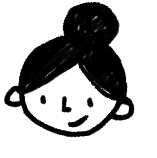A structure for practice
This is part 3 of a three-part mini series on practice.
Read part 1: "My personal learning curve"
Read part 2: "Making practice playful"
No matter what I practice, there is a simple structure that I use. It helps me to make the most of my practice and to make sure I take something from the practice into the work I do.
There are three steps:
1. Explore
Pick a particular aspect you want to explore in your practice. This could be exploring size, spacing, colour, contrast, posing, exaggeration, stroke thickness, or anything to focus on and play with during practice. If you pick playing with size, for example, try to change up the size of things you are sketching in your practice. What happens if you sketch much smaller than usual…or much bigger? How do your sketches change when you mix shapes of very different sizes? How do different proportions influence the meaning of your sketches? Etc.
Once you picked your focus, go wild. Try out a lot of different things. Go broad, go deep. Dive into the details. Experiment.
Practice gives you the possibility to really experiment without the pressure of the result having to be good, usable or appropriate. You want to push out of your comfort zone, push things until they break. Like that you can explore the boundaries of what you usually do and you will probably make some interesting discoveries that usually don’t happen in your regular work when you focus on solving a problem and producing a piece that solidly ‘works’.
2. Observe
The next step is to observe what is happening in your explorations. How do the sketches change when you push them in different directions? When do they break? How does the style and the meaning change when you play with different parameters?
This step requires paying attention to the details, allowing yourself to notice subtle shifts in the quality of the work. Be interested in your own work! As a practitioner, it is your job to be interested. Nothing in itself is interesting, it becomes interesting when you put your attention and interest in it. Over time, you’ll become much better at noticing details of interest – not only in your own work, but also in the work of others. You’ll start spotting the finer details which make their work look so great or interesting… and you’ll be able to take these details into your own practice and use them as a new focal point to play with.
3. Pick up the goodies
After you explored and observed, it’s time to reflect a bit more on what you just did. It’s time to go through your experiments with a more analytical mind. Which your sketches do you like? Which ones are oddly interesting? Which ones really work? And why? What did you do, that makes them ‘better’ than others on the page.
Make a mental (or physical) note of those sketches and try to use the same approach in your future work. An example could be that you played with size and you discover that the times when you used very contrasting sizes in one sketch, the results are really interesting and very different from your normal work. Make a note of that and try to consciously use more size variation in your usual work. You can even re-sketch some of the ‘good’ sketches from your practice, emphasising the aspect you want to keep and pin them around your workspace as a reminder.
Get yourself into trouble
Practice has a great advantage: you just do it for yourself without the pressure of having to produce anything good or usable. You have the freedom to screw up, to make mistakes, to get yourself into (visual) trouble without any bad consequences. So why not use this freedom to do all these things and see what happens? Try to push your experiments until they fail. See what it feels like to screw up. You might discover that it is not that bad after all, and that it can be quite a lot of fun to get yourself into trouble and to sketch your way out of it again.
Embracing the challenge of working with whatever is in front of you and trying to make the best out of it will make you more confident to take chances in your regular work. If you know that you can sketch yourself out of sticky situation, you’ll be more open to pushing your work beyond the obvious and safe. What seemed like ‘taking risks’ before will become a more positive action of ‘taking chances’. Instead of being afraid to fail, you learn to be curious about what is going to happen.
Over to you!
Now turn off your computer and get practicing. Just a little every day. Be curious. Have fun. And don’t forget to get yourself into trouble every now and again :)
This is part 3 of a three-part mini series on practice.
Read part 1: "My personal learning curve"
Read part 2: "Making practice playful"




